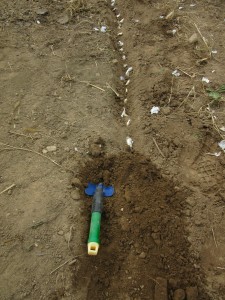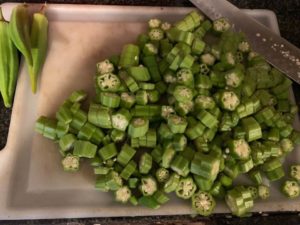(just a quick note, I’ll update this with pictures through the season as onions get bigger, I am working with the pictures I took from last season, which apparently ended with transplanting, lol)

If there was ever a confusing vegetable to pick out, I think onions would take that title. Onions are classified by their shape (flat, round or globe), or color (red, white, yellow), pungency, how well they store, and how the bulb responds to different lengths of daylight. Onion varieties are suited for different climates, and come with descriptions such as “short day” or “long day” or “intermediate day/neutral.” To complicate things further, you can grow onions from seed, seedlings/transplants, or sets. Some are considered sweet, others are considered storage… What does all of this mean?? To someone who has never grown onions before, this can be very confusing. This new gardener may just pick a variety blindly, then grow it unsuccessfully because it wasn’t well suited to their climate. Don’t be that gardener! Let’s talk a little bit about picking the right variety for you, and how to grow them, because they all grow the same (and that’s the easy part!).
Fun fact: Onions grown for their immature green stems are called bunching onions or scallions. You can harvest any onion early and use it as a bunching onion! But, bunching onions left in the ground too long won’t always produce a large bulb.
Let’s settle the confusion on long, short, or intermediate day onions. This refers to the type of climate and amount of sunlight the onion grows best in. The amount of sunlight is important, because that is what causes the bulb of the onion to form.
- Long Day: These onions require 14 hours of daylight or more in the summer, which occur from zone 6 up to the north. The long day onions are best suited to our area. Long day onions can be started indoors in late winter for a mid to late summer harvest, and generally mature in 90-110 days. You can have success with these onions in our area if we have the right kind of summer. If we don’t, your bulbs may not be as big as they could be. Common varieties include: Walla Walla, Red Cipollini, Southport Globe (red and white), Sweet Spanish (white and yellow), among others.
- Intermediate/Neutral Day: These onions are best suited where they will get 12-14 hours of sunlight each day. They generally mature in about 110 days. Plant seeds indoors in early spring for a mid-late summer harvest. Common varieties include: Candy Onion, Early Yellow Globe, Australian Brown, White Portugal, Southport Yellow Globe, among others. The intermediate day onions are sort of a ‘buffer’ between long and short day onions and tend to grow decently in either a well as their own area.
- Short Day: these onions are best suited for zones 7 southward, where they will get 10-12 hours of sunlight per day and generally mature in about 110 days. These varieties don’t generally do well in our area, but you can try grow them.
Next question is, should you plant seeds, buy seedlings, or sets?
If you plant seeds, you have a wide variety of onion varieties available to you. You can choose from some at garden centers/greenhouses, or order from seed suppliers online. You will usually end up with more seeds than you will have room to start/plant, but they can be saved for the following year. Onion seeds are good for 1-4 years when stored properly
If you grow seedlings, or buy transplants, your onion plants will have their head start, all you will need to do is set them in the ground when the time is right. Selection on variety is limited this way, but if you don’t have the ability to start seeds indoors yourself, this is the next best thing.
Onion sets are another way you can grow onions, but varieties are extremely limited in stores. Sets are onion plants (small bulbs) that were started the previous year. Onions that are in their second year are preparing to set seed, so the onions will not grow very large.

Growing
Onions are one of those vegetables that are best started indoors in our location – and start them indoors early! I start mine mid to late January for a summer harvest, but you could wait until about mid-February. Onions can be set out 3-4 weeks ahead of our last frost date, of course weather permitting (if there is still snow on the ground, that’s a good indication that it’s still a bit too soon, haha), and many require a long growing season. Being able to get them started indoors gives them the opportunity for a head start for the best quality onion possible.
For indoor seed starting specifics, visit this post. Onions follow the same basic guidelines of:
- Select a seed starting container that will tolerate moisture, is the right size, and has drainage holes in the bottom.
- Fill the container with seed starting mix or potting soil, then lightly press on the surface to create an indent.
- Onion seeds can be started indoors 8-12 weeks before you intend to put them out. They may be able to be put outside 3-4 weeks before your last frost. This can mean starting them indoors 16 weeks before your last frost.
- Place your seeds in the indent. You can sow single seeds per plug or cell, or you can multisow them – 3-5 seeds per hole. Onions are one of the few plants that can be multisown quite easily to conserve space, their roots generally separate very easily with minimal damage to transplant.
- Cover the seeds with an thin layer of soil, cover with plastic wrap if you will be starting them in a very dry location that lacks humidity, keep the soil around 60-70 degrees (F).
- When seeds begin to sprout, begin placing the seedlings within 2-4 inches of an overhead light, such as a fluorescent light, 12-16 hours per day.
- When your onion seedlings get to be a few inches tall and the tops start tangling with the others, it’s time to give them a haircut. Each time you give them a “hair cut”, it forces the onion to put energy into growing roots, which in turn will help grow bigger bulbs. Trim the onions to about 1-1/2-2 inches with a pair of scissors. Do this several times before planting them outside, allowing them to get a little taller with each trim.
- If your onions roots begin to get crowded transplant them to a larger container.
- When the weather is favorable for transplanting, begin to harden seedlings off and transplant in loose soil, 2-4 inches apart I like to dig my rows and line the rows with aged compost that will help give the onions a great start in their new home.
- Weed control is important, as is moisture. To prevent a lot of weeds, you can plant leafy greens in the rows between the onions. They will provide shade over the soil, which will deter some weed growth. The shade will also help the soil retain some moisture as it won’t be baked away in the sun. Mulching is also beneficial.
- Harvest when the tops fall over, when the majority of the leaves are dry. Leave 1-2 inches of stem on the onion, then spread them in a sunny or dry location to dry (about 3-7 days).
What onions are your favorite?













